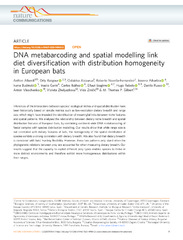Приказ основних података о документу
DNA metabarcoding and spatial modelling link diet diversification with distribution homogeneity in European bats.
| dc.creator | Alberdi, Antton | |
| dc.creator | Razgour, Orly | |
| dc.creator | Aizpurua, Ostaizka | |
| dc.creator | Novella-Fernandez, Roberto | |
| dc.creator | Aihartza, Joxerra | |
| dc.creator | Budinski, Ivana | |
| dc.creator | Garin, Inazio | |
| dc.creator | Ibáñez, Carlos | |
| dc.creator | Izagirre, Eñaut | |
| dc.creator | Rebelo, Hugo | |
| dc.creator | Russo, Danilo | |
| dc.creator | Vlaschenko, Anton | |
| dc.creator | Zhelyazkova, Violeta | |
| dc.creator | Zrnčić, Vida | |
| dc.creator | Gilbert, M. Thomas P. | |
| dc.date.accessioned | 2020-03-30T16:07:38Z | |
| dc.date.available | 2020-03-30T16:07:38Z | |
| dc.date.issued | 2020 | |
| dc.identifier.issn | 2041-1723 | |
| dc.identifier.uri | http://www.ncbi.nlm.nih.gov/pubmed/32123172 | |
| dc.identifier.uri | http://www.pubmedcentral.nih.gov/articlerender.fcgi?artid=PMC7052159 | |
| dc.identifier.uri | https://radar.ibiss.bg.ac.rs/handle/123456789/3628 | |
| dc.description.abstract | Inferences of the interactions between species' ecological niches and spatial distribution have been historically based on simple metrics such as low-resolution dietary breadth and range size, which might have impeded the identification of meaningful links between niche features and spatial patterns. We analysed the relationship between dietary niche breadth and spatial distribution features of European bats, by combining continent-wide DNA metabarcoding of faecal samples with species distribution modelling. Our results show that while range size is not correlated with dietary features of bats, the homogeneity of the spatial distribution of species exhibits a strong correlation with dietary breadth. We also found that dietary breadth is correlated with bats' hunting flexibility. However, these two patterns only stand when the phylogenetic relations between prey are accounted for when measuring dietary breadth. Our results suggest that the capacity to exploit different prey types enables species to thrive in more distinct environments and therefore exhibit more homogeneous distributions within their ranges. | en |
| dc.relation | COST Action “CLIMBATS—Climate change and bats: from science to conservation” | |
| dc.rights | openAccess | |
| dc.rights.uri | https://creativecommons.org/licenses/by/4.0/ | |
| dc.source | Nature Communications | |
| dc.subject | Behavioural ecology | |
| dc.subject | Biogeography | |
| dc.subject | Community ecology | |
| dc.subject | Ecological genetics | |
| dc.title | DNA metabarcoding and spatial modelling link diet diversification with distribution homogeneity in European bats. | en |
| dc.type | article | en |
| dc.rights.license | BY | |
| dcterms.abstract | Ребело, Хуго; Aизпуруа, Остаизка; Aлберди, Aнттон; Aихартза, Јоxерра; Ибáñез, Царлос; Изагирре, Еñаут; Зрнчић, Вида; Будински, Ивана; Гилберт, М. Тхомас П.; Зхелyазкова, Виолета; Власцхенко, Aнтон; Руссо, Данило; Гарин, Иназио; Разгоур, Орлy; Новелла-Фернандез, Роберто; | |
| dc.rights.holder | © 2020, The Author(s). | |
| dc.citation.issue | 1 | |
| dc.citation.volume | 11 | |
| dc.identifier.doi | 10.1038/s41467-020-14961-2 | |
| dc.identifier.pmid | 32123172 | |
| dc.identifier.scopus | 2-s2.0-85080912059 | |
| dc.identifier.wos | 000520939300002 | |
| dc.citation.apa | Alberdi, A., Razgour, O., Aizpurua, O., Novella-Fernandez, R., Aihartza, J., Budinski, I., et al. (2020). DNA metabarcoding and spatial modelling link diet diversification with distribution homogeneity in European bats. Nature Communications, 11(1), 1154. | |
| dc.citation.vancouver | Alberdi A, Razgour O, Aizpurua O, Novella-Fernandez R, Aihartza J, Budinski I, Garin I, Ibáñez C, Izagirre E, Rebelo H, Russo D, Vlaschenko A, Zhelyazkova V, Zrnčić V, Gilbert MTP. DNA metabarcoding and spatial modelling link diet diversification with distribution homogeneity in European bats. Nat Commun. 2020;11(1):1154. | |
| dc.citation.spage | 1154 | |
| dc.type.version | publishedVersion | |
| dc.identifier.fulltext | https://radar.ibiss.bg.ac.rs/bitstream/id/6048/NatCommun_2020_11_1_1154.pdf | |
| dc.citation.rank | aM21 |

